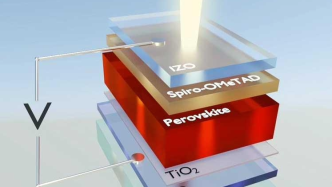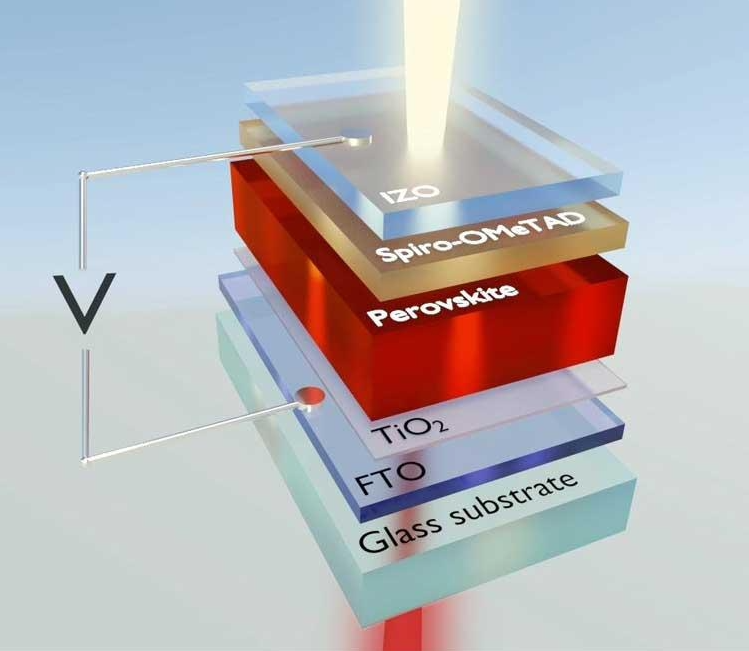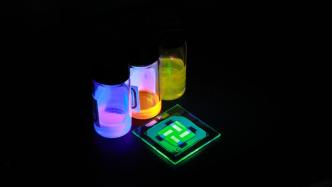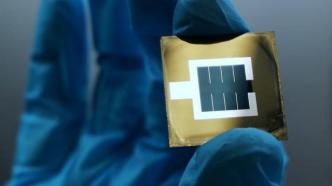
Recently, researchers from the Institute of Solid State Physics, Hefei Institute of Physical Sciences, Chinese Academy of Sciences (hereinafter referred to as the Institute) and the Key Laboratory of Photovoltaic and Energy-Saving Materials, Chinese Academy of Sciences, and Tian Xingyou’s team met with Professor Nam-Gyu Park from Sungkyunkwan University, South Korea, and North China Electric Power University Professor Dai Songyuan collaborated and discovered for the first time that uneven cation distribution is the main reason affecting the performance of perovskite solar cells, and successfully prepared a "homogenized" perovskite solar cell, achieving a photoelectric conversion efficiency of 26.1% and a certified efficiency of 25.8 %. Relevant research results were recently published online in Nature.

Perovskite cell structure diagram, pictures from the Internet.
It is worth mentioning that it only took more than a week from the official receipt of the paper to the publication of the paper.
"This research provides a clear direction for further improving the performance of efficient and stable perovskite solar cells, and is of great significance in promoting their commercial development." Pan Xu, co-corresponding author of the paper, told China Science News.
A reviewer of "Nature" commented on the results and said, "This work provides valuable insights into the effective suppression of ion phase segregation in the perovskite field and will help promote the commercialization of perovskite solar cells."
"Rookie" in the field of solar cells
Solar energy is the most important source of energy for life on earth. It is inexhaustible and cleaner and more environmentally friendly than traditional energy sources such as coal and oil. Scientific researchers invented solar power generation technology to convert light energy into electrical energy for production and living needs. Perovskite solar cells are a “rookie” in the field of solar cells.
"I want to popularize a concept here. Perovskite is not a mineral, but a crystal structure. It has very high absorption and conversion efficiency for visible light, and is inherently capable of producing high-efficiency solar cells." Pan Xu said .
"The efficiency improvement of perovskite solar cells is unprecedented." Pan Xu made a comparison. It took nearly 80 years to increase the efficiency of crystalline silicon solar cells from the initial 3% to the current 26%; and perovskite solar cells It only took more than 10 years to increase the efficiency from 3.8% to the current 26%.
In addition to excellent efficiency, perovskite solar cells have a simple manufacturing process and low cost. At room temperature, several chemicals are mixed in a solution, and then the solution is "brushed" on the substrate like "painting a wall" to obtain a perovskite film. Finally, functional layers such as electron transport layers and metal electrodes are added, and a perovskite solar cell is completed.
"A perovskite solar cell is about 1 micron thick, which is equivalent to one percent of the thickness of an A4 paper." Pan Xu explained that thinness means that the overall weight of the battery itself is very light and can be superimposed on existing For crystalline silicon solar cells; thin means good light transmittance and can capture more light energy; thin means strong flexibility and is expected to be used in aerospace and wearable devices in the future.
However, there are still some problems with such a "perfect" perovskite solar cell. For example, poor stability, the current outdoor service life of only 2 to 3 years, and a significant slowdown in the improvement of photoelectric conversion efficiency are the core issues that restrict the industrial development of perovskite solar cells and are also the difficulties for scientific researchers.
In this work, Pan Xu and others discovered for the first time that the cations in the perovskite film were unevenly distributed in the vertical direction, so they proposed a "homogenized" cation phase distribution strategy and prepared a high-efficiency perovskite solar cell, achieving 26.1 % photoelectric conversion efficiency, and the continuous light stability test reaches 2500 hours.
"Cool" high resolution
After the paper was published online, Pan Xu’s mobile phone messages exploded, with many colleagues in the industry sending congratulatory messages. One message read: "This high resolution is cool."
Pan Xu felt a little satisfied when his research highlights were “pointed out” by his peers.
In the past 10 years of development, a large amount of research work has focused on the properties and optimization of the perovskite film plane. The interior of the perovskite film is like a "black box", and people lack an in-depth understanding of its crystal growth and component distribution. , basically rely on inference.
"Relying on inference is not enough. Scientific research requires evidence." Pan Xu said bluntly.
Based on years of research on high-performance perovskite solar cells and the properties of perovskite films, Pan Xu and others have launched research on this issue.
They first deeply analyzed the X-ray photoelectron energy spectrum and clearly observed the distribution of elements inside the perovskite film from a microscopic perspective. Then, through high-resolution electron microscopy, they directly "saw" the difference in crystal interplanar spacing, which showed that different sizes of Cations are present in different locations, i.e. cation inhomogeneity. Large-sized cations are enriched at the interface on the film, while small-sized cations are enriched at the bottom of the film.
"The electron transmission channel inside the perovskite film is like a road. These cations of different sizes are obstacles, which hinder the advancement of electrons and naturally cannot improve the battery efficiency." Dr. Ye Jiajiu, co-corresponding author of the paper and Institute of Solid State Research, said.
So why does this happen? To answer this question, the team and the Shanghai Synchrotron Radiation Source developed a new testing method, namely in-situ grazing incidence wide-angle X-ray diffraction, to monitor the internal crystal growth of the perovskite film throughout the process.
Research has found that the crystallization rates of cations of different sizes vary greatly during the formation of crystals. Large-size cations crystallize slowly, while small-size cations crystallize quickly, resulting in uneven distribution of perovskite films.
Ultimately, they designed an additive that synchronizes the crystallization rates of different cations and aligns them evenly to facilitate charge transport.
Pan Xu said: "This result shows that by uniformizing the distribution of perovskite cations in the vertical direction, excellent battery performance can be obtained, opening up a new way to improve the stability of battery devices, and is expected to break through the efficiency bottleneck of perovskite solar cells. .”
"Do practical research"
Pan Xu was one of the earlier researchers in China to engage in perovskite research. "The reason why we chose this direction is that the perovskite material itself has excellent photoelectric properties, early development potential and a theoretical limit efficiency of up to 33%. It has an irresistible attraction for researchers in the photovoltaic industry." Pan Xu said with a smile.
However, he was not confident at first. "At that time, when we held the perovskite thin-film battery we had produced, we could see with the naked eye that it slowly turned from black to yellow, and the light absorbance became worse." Pan Xu recalled the early days of perovskite research.
After more than 10 years of hard work, Pan Xu and others have made major breakthroughs. Recently, the research results were published in Nature. He said, “Perseverance is the most important quality in doing scientific research.”
At 1 a.m. on the day the paper was published online, Pan Xu, who was sitting in his office, posted this to a circle of friends - "The road ahead is still long, with heavy rains and bumps, so just keep going. Just enjoy the scenery along the way. Even if you can’t see the end, it’s still a kind of enjoyment.”
"I want to tell my students that doing scientific research is not just for publishing articles. I also hope that everyone can do practical research and do research that has an impact on the national economy and people's lives, even if it only plays a small role." Pan Xu said , this is what he thinks is the greatest significance of doing scientific research.
"This work is just the beginning. We will continue to explore further in this direction, hoping to develop improved additives to improve the efficiency and stability of perovskite solar cells." Talking about the future of perovskite solar cells Pan Xu is full of confidence in development.
Related paper information:
https://doi.org/10.1038/s41586-023-06784-0
(Original title: "Birth of Perovskite Cell with 26.1% Photoelectric Conversion Efficiency")

